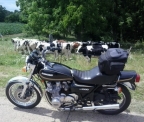- Posts: 1013
- Thank you received: 117
Carb Stand from old carb holders.
- spdygon
-

- Offline
- Platinum Member
1982 GS1000sz Katana ( #15...17K Miles)
1982 GS1000sz Katana ( # 297....7100k Miles)
1978 Kz1000 Z1R. 10K Miles1
1978 kz1000 z1r 27k miles
1977 KZ 1000 A ( Project ) 54K Miles
1976 Kz900A4 (Red)21K miles
1976 Kz900A4 ( Red)7500 miles
1974 Z1 900 project
Please Log in or Create an account to join the conversation.
- SWest
-

- Offline
- Sustaining Member
- 10 22 2014
- Posts: 23027
- Thank you received: 2758
Steve
Please Log in or Create an account to join the conversation.
- floivanus
-

- Offline
- User
- Posts: 1055
- Thank you received: 116
NakedFun wrote:
floivanus wrote: Jiggling carbs would cause sync disturbance because of the slop inherent in the design (pivot shaft, arm that goes ro slide, dampening springs in slide, slide adjusters and slide fit in the bore.
Not exactly sure what lou means, but considering he is one of the electrical gurus on here I tend to listen to what he says
Well I'll just say this, if simply jiggling the carbs sets sync out of whack, I would guess between the engine vibrations and shock emitted from the chassis as the bike moves would never leave the bike in sync....
I would suspect you have some pretty worn (and leaking) cross shafts and linkages.
Anyway, back to the discussion of bench carb stands for maintenance.
Cory
And that's the thing, jiggling does make them off kilter a minute amount, if it goes worse than that they need looked at. Ergo what lou was saying, and yes thread hijacking seems rampant. Don't know how this got off course.
For a carb holder I just use a spare gs750 head. Tried selling it, now it's a carb holder. Or IF I'm too lazy for that I use the handle of my outdoor recycling bin
my bikes; 80kz1000(project), 77 gl1000, 74 h2 (project)
Past; 78 kz1000, 83 kz550
Andrew
Please Log in or Create an account to join the conversation.
- SWest
-

- Offline
- Sustaining Member
- 10 22 2014
- Posts: 23027
- Thank you received: 2758
Steve
Please Log in or Create an account to join the conversation.
- loudhvx
-
 Topic Author
Topic Author
- Offline
- KZr Legend
- Posts: 10864
- Thank you received: 1615
I'm not drinking anything. Let me spell it out.car5car wrote:
Wiggling should not change anything is clamps are tight.loudhvx wrote: you can alter the sync by 5 to 10 mm of mercury just by wiggling the carbs around a little on the engine. If it goes to over 10, I like to re-sync, though they say up to 20mm is ok. But I notice a difference in the running by then. Installing the carbs, especially with an airbox, is going to require a sync check for sure.
I didn't mean a bench sync was totally useless on a good engine. I meant the bench sync was not a good means of getting a final sync. A bench sync is always a good starting point. I just think a final sync should be done on the bike (assuming compression and valves are all set and good), and might as well since you'll have to set it up to check anyway (thus saving the extra time you would use to precisely sync the carbs on the bench).
If one cylinder is unable to flow as much air as the other cylinders (a low compression reading will show this), for whatever reason, it's vac reading will be lower than the others when all throttles are at the exact same opening. That cylinder will do less work since it gets less air. What's worse is, a vacuum sync would have you close down that one throttle to get the vacuum reading back up to where the other cylinders are at. So you have then reduced the airflow to the weak cylinder even more, and thus it will do even less work. This increases the uneveness of the idle.
Using vacuum to sync throttles is based on the assumption that all cylinders are in the same condition (and all carbs and carb holders are in the same condition, meaning not leaking air somewhere).
I suggest that the smoothest sync would be to time the intervals between firing and adjust the throttles so the interval was the same for all cylinders, but I've never tried to do it that way. It wouldn't be too hard with a scope. It would be interesting to see what the vacuum ends up at if done this way.
Firing interval? What are you talking about? You are going to change firing intervals by adjusting synchronizing? How many beers did you have?
An interval is the time elapsed between two events.
Firing interval is the time between the firing of one cylinder to the next.
If the firing interval for each cylinder is the same as the others, then the average rotational speed, contributed by each cylinder, to the crankshaft is the same. That would produce a smooth idle.
If one cylinder causes the crank to spin faster to the next cylinder's firing point, then that cylinder's firing interval is shorter.
This implies that cylinder is firing more charge. You could then adjust that cylinders throttle plate to achieve a firing interval equal to the others.
Having all intervals the same would produce a smooth idle, instead of a loping idle.
1981 KZ550 D1 gpz.
Kz550 valve train warning.
Other links.
Please Log in or Create an account to join the conversation.
- loudhvx
-
 Topic Author
Topic Author
- Offline
- KZr Legend
- Posts: 10864
- Thank you received: 1615
NakedFun wrote:
floivanus wrote: Jiggling carbs would cause sync disturbance because of the slop inherent in the design (pivot shaft, arm that goes ro slide, dampening springs in slide, slide adjusters and slide fit in the bore.
Not exactly sure what lou means, but considering he is one of the electrical gurus on here I tend to listen to what he says
Well I'll just say this, if simply jiggling the carbs sets sync out of whack, I would guess between the engine vibrations and shock emitted from the chassis as the bike moves would never leave the bike in sync....
I would suspect you have some pretty worn (and leaking) cross shafts and linkages.
Anyway, back to the discussion of bench carb stands for maintenance.
Cory
Have you tried it?
I do it on every sync in order to didder out the unequal stresses in the carb rack due to carb holders, airbox, heat expansion etc. If you are not doing this, I recommend it. Just grab the rack, one hand on 1, and the other on 4. Watch the sync tool as you twist and jiggle the carbs. Every bike I've ever synced does this. It is impossible to apply force to metal and have absolute zero deflection.
I used the word didder (didderen), but the modern term for this is dithering. Didder comes from what bombers had to do to with their bomb sights to make them more accurate during WWII. Wikipedia probably has a good explanation. This concept is used in engineering.
Basically, by randomly jiggling something, you make it's average position equal to it's equilibrium position. That is the position where the object is at most rest. That's where you want your carbs to be. But when you install carbs, you impart a force that may leave them in a position that is not at the equilibrium position. Such as when you wiggle the carbs up and down to seat them in the carb holders. If your last motion was to wiggle upward, the carbs are in a slightly upward position, and they may be unevenly pulled upward. If you sync them there, and then they later fall to their equilibrium position, the sync will change.
By wiggling the carbs gently a few times, gradually using less force each time, the carbs end up closer to their full resting position. Then you sync them. I go back and wiggle them again since using the screwdriver to adjust the sync causes you to push down on a carb. I also blip the throttle to make sure all slides are dropped to their full resting position.
After all this is done, I can whack the carbs around and the sync will be off again, but by blipping the throttle and letting the engine run, they eventually return to fully synced. That's the goal: have the carbs return to their original sync by themselves after being disturbed.
So the point is, if you jiggle the carbs to gradually find it's full resting position, it won't matter if you run over bumps etc. Through vibration, the carbs will be at their resting position, or vibrating around their resting position. Either way, the average sync stays the same. That is the same concept behind diddering their bomb sights.
BTW, thanks Andrew, for the compliment.
KZR traffic has been slowing down, so any productive discussion is welcome, even if I'm jacking my own thread.
1981 KZ550 D1 gpz.
Kz550 valve train warning.
Other links.
Please Log in or Create an account to join the conversation.
- SWest
-

- Offline
- Sustaining Member
- 10 22 2014
- Posts: 23027
- Thank you received: 2758
Steve
Please Log in or Create an account to join the conversation.
- bluej58
-

- Offline
- Sustaining Member
- The chrome don't get you home
- Posts: 2481
- Thank you received: 511
I have a love hate relation with my original carbs, I should still have a nice day to re tune and see if that helps.
It would be nice to park it with that squared away.
Possible snow storm tomorrow night.
78 KZ1000 A2A
Please Log in or Create an account to join the conversation.
- NakedFun
-

- Offline
- User
- Posts: 1095
- Thank you received: 99
You are simply trying to equalize the vacuum signal at the carb. The vacuum being generated is being developed by the sealing and dynamic airflow characteristics of the cylinder/head/intake system and cam timing. Assuming that something is not so far out of whack from one cylinder to another in regards to it sealing and combustion capability, it's ability to develop the same torque as the cylinder next to it. If all cylinders are producing the same torque, i.e providing the same work to the total output of the engine, it will be at its smoothest. How do you ensure the torque output is the same per cylinder? Well that is called CMEP or Cylinder Mean Effective Pressure. This is the amount of pressure the combustion event exerts on the top of the piston, forcing it down. The connecting rod and offset of the crankshaft convert that downward force into a rotational movement with a lever arm, this developing torque. So what does that mean? Assuming the cylinders are the same size and relatively the same condition, what is going to affect that force is the pressure. What is going to affect the pressure? The combustion event. What affects the combustion event? The air and fuel. So by ensuring the engine is in good operating condition and pulling the maximum amount of air is by ensuring the valve clearances are set appropriately. This affects the dynamic cam timing, which directly correlates to that cylinders breathing. Next, we need to look at the whole fuel thing....
So fuel needs to be delivered in the right amount. This is based on the chemical composition of the gasoline. You may think about this as an ideal air fuel ratio for gasoline is called Stochiometric. Basically the ratio at which all of the hydro carbon chain is utilized leaving nothing left over or partially consumed. However in a performance engine that is naturally aspirated, a slightly rich ratio typically produces the most power. If Stoicho is 14.7:1 the typical AFR that produces the most power is around 12.5:1 to 13.5:1 as a general rule of thumb. So now that we know what our target to hit is, how do we ensure we are delivering that amount of fuel to that cylinder. Without pyrometers on each cylinder, we go by what Mama Kawi says. They tell us what that vacuum signal at that carb should be. This is because vacuum, thanks to Bernulli and Venturi, is how we get fuel to draw into the cylinder.
They have figured out pulling "X" vacuum on that carb will yield so much fuel to the cylinder. So if we go back to the whole cylinders relatively the same, then we want them applying the same force to their piston. That means we want to send each of those cylinders the same amount of fuel. This means we want the vacuum signal at that carb to be the same.
Now I have said all along that carbs should be finally sync' do the bike, engine warmed up (especially important with air cooled), idle speed set to target, with each adjustment followed by a quick/short blip of he throttle and letting the bike settle right back down before making another adjustment until all readings are within the given spec of each other.
The last thing I will say is firing interval
iS set by ignition firing order. You cannot have one cylinder accelerating faster than the other unless the crank is broke.....
I am tired now and frankly understand we all come from different backgrounds and have our own ways of doing things. I typed the above not to stir crap, but to add to the discussion.
Cory
2008 Kawasaki Concours 14
1999 Kawasaki ZRX1100
1976 Kawasaki KZ900
Please Log in or Create an account to join the conversation.
- loudhvx
-
 Topic Author
Topic Author
- Offline
- KZr Legend
- Posts: 10864
- Thank you received: 1615
There is no carb rack that is infinitely rigid. They can all get deflected through vibration or installation. The point is to get them to their resting position before or during a sync. If the carbs have been on the bike for a long time it's not an issue since they have found their resting position, as long as they don't get disturbed too much in the process. But we are talking about carbs that have been off the bike.
But that goes against the original premise. The premise is that one cylinder's poor condition is causing it to be too "far out of whack" for it to have the same vacuum as the other cylinders at a given RPM when all throttles are at the same opening. Under that condition, a vacuum sync will do more harm than good (due to the aforementioned effect of causing the tuner to close the throttle on the weak cylinder in order to increase the vacuum).... Assuming that something is not so far out of whack from one cylinder to another in regards to it sealing and combustion capability, ...
Regarding the other method of syncing:
Yes getting the same pressure, or doing the same work, or making the same torque will get a smooth idle, but that smooth idle can also be felt as a string of pulses, so the time between pulses can be used to indicate smoothness too. If all pulses are timed the same, we can assume every cylinder is doing its share to rotate the crank at the same average speed. This indicates they are all doing the same work and/or providing the same torque etc. My point is, if we use the pulse timing to adjust the sync rather than manifold vacuum, we don't care if a cylinder is "out of whack". We will just end up giving it slightly more throttle to compensate. With this method, we would be tuning for smoothness rather than even vacuum. When we sit on the bike and feel a rough idle, we are not really noticing vacuum, we are noticing unequally timed power pulses. If the vacuum is uneven by a couple inches, we don't care, as long as the idle feels perfectly smooth. (Of course it's best to just fix the weak cylinder, but that is not always an option.)
And BTW, I primarily only use vacuum for syncing carbs. But I have used other methods in past. In fact, I think I've read Honda Twins manuals that have you sync carbs by looking at the RPM each carb can achieve on it's own. I know I've done it that way on twins for several years. That is a similar concept, but not useful on a four cylinder, since a four will not likely run on one cylinder without a drastic change on the throttle's idle position. (And of course, pulse timing can't be used on a non-360 crank twin.)
1981 KZ550 D1 gpz.
Kz550 valve train warning.
Other links.
Please Log in or Create an account to join the conversation.
- NakedFun
-

- Offline
- User
- Posts: 1095
- Thank you received: 99
1. I nor anyone said we were taking the carbs off due to a cylinder performance issue. In fact this thread which is really out of control now, was about carb stands. Stands that are probable just used to service some carbs that need attention due to stale fuel, leaking gaskets, etc..,,
2. I (now regrettably) mentioned that I have considered a stand with some means to draw a vacuum in the carbs. Why? When you completely rebuild most older carbs, there is a base line setting they get set to PRIOR to reinstallation and proper sync to the engine itself. The factory service manual will call out a very small dimensions that the center of the bottom edge of the slide should be from the bottom of the body inlet bore. You then use the adjustment to set them all at this point. Some will call this a bench top sync. I have a calibrated set of pin drills O use when I set this. This is simply so they are all as close to one another as they can be so you are not wasting time during the sync chase readings due to one being more open than another. I have thought a simple method would be to use vacuum at this point and baseline them as that is defining measure the factory is trying to get at with the measurement method.
3. I have said repeatedly in this thread YOU STILL MUST SYNC to the ENGINE that is in good running order. This means all specs including valve clearance, leak down, blow by, etc is in serviceable range.
4. The pulses you keep talking about, are timed by three things: ignition firing order, camshaft timing, and crank throw angles. Carbs do not change the firing interval or in simple terms, when each cylinder goes "boom". That uneasiness that you talk about is because one cylinder is firing improperly. What happens when it doesn't fire properly, you don't have the same amount of work or torque being output by that cylinder as compared to the others.
5. Most of the time ther are a great number of things that cause a rack of carbs to go out of sync. Sometimes it could be the intermediate linkages, a lot of times it is valve regression into the head causing valve clearance to go to tight. It may be cylinder wear, or even simple vacuum leaks like carb intakes. That is why it is scheduled maintenance....
Listen, you obviously feel strongly about your ways of thinking about tuning an engine and that is great, but I for one am more interested in the tools that people are making to keep thes old bikes running. I am done with explaining the way I know and have learned through the years and in my profession. Thanks.
Cory
2008 Kawasaki Concours 14
1999 Kawasaki ZRX1100
1976 Kawasaki KZ900
Please Log in or Create an account to join the conversation.
- SWest
-

- Offline
- Sustaining Member
- 10 22 2014
- Posts: 23027
- Thank you received: 2758
Steve
Please Log in or Create an account to join the conversation.
